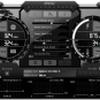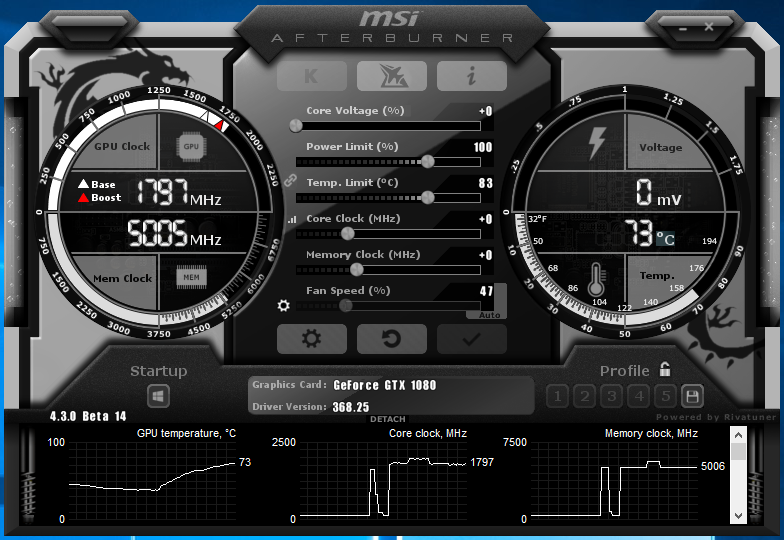This is the new public BETA release of MSI AfterBurner 4.3.0 (Beta 14). Over the past few weeks we have made tremendous effort to get a lot of features enabled for this now DirectX 12 compatible build. All recently released graphics cards are supported.
This entails the entire Nvidia GeForce GTX Series 10 including Nvidia Titan X (Pascal) and for AMD the Radeon RX series 480, 470 and 460. Not just that, we have also updated RTSS, our statistics server that enables the overlay with MSI AfterBurner, yes we now offer DirectX 12 overlay support (albeit this build again is in BETA stages and should be treated as such).
Have fun tweaking and remember, this is an open BETA, not the final. Please use and grasp it as such.
Revision history Version 4.3.0 Beta 14
- Added AMD Ellesmere and Baffin graphics processors families support
- Added Overdrive N (Overdrive 7) technology support for AMD Polaris architecture based graphics cards
- Added core voltage control for reference design AMD RADEON RX 460, AMD RADEON RX 470 and AMD RADEON RX 480 series cards with on-die SMC voltage controller
- Added memory controller usage graph to hardware monitoring module for AMD graphics cards. Currently memory controller usage monitoring is implemented for AMD Ellesmere and Baffin graphics processors families only
- Added GPU power draw graph to hardware monitoring module for AMD graphics cards. Currently GPU power draw monitoring is implemented for AMD Ellesmere and Baffin graphics processors families only
- Added “Erase autosaved startup settings” option to “AMD compatibility properties” section in “General” tab. Starting from AMD Crimson drivers family, the driver is automatically saving hardware settings (e.g. overclocking or fan control settings) in the registry and apply it at Windows startup. It makes settings of any third party hardware overclocking tool virtually permanent, meaning that applied settings stay in the system even after rebooting or powering down the system. However, such implementation is unsafe and even potentially dangerous, because you're no longer able to undo unsafe overclocking with system reboot or even driver reinstall. To prevent such situations, MSI Afterburner can now optionally erase AMD driver's autosaved startup settings after applying new settings to hardware
- Added GPU Boost 3.0 technology support for NVIDIA Pascal graphics cards:
- Added percent based overvoltage support.
- Added voltage/frequency curve customization support. You may use traditional core clock slider on NVIDIA GeForce GTX 1070 and 1080 graphics cards to apply fixed offset to all voltage/frequency curve points as well as use brand new flexible voltage/frequency curve editor window for more precise per-point curve adjustment. The editor window can be activated either with <Voltage/frequency curve editor> button in the main application window or with <Ctrl> + <F> keyboard shortcut and it provides you the following features: You may independently adjust clock frequency offset for each point with mouse cursor or <Up> / <Down> keys
- You may hold <Ctrl> key to set anchor and fix clock frequency offset in minimum/maximum voltage point and adjust the offset of any other point with mouse to linearly interpolate the offsets between the anchor and adjustment points
- You may hold <Shift> key while adjusting the offset of any point with mouse to apply the same fixed offset to all points. That’s equal to adjusting the offset with the slider in main application window.
- You may press <Ctrl> + <D> to reset offsets for all points You may switch between traditional core clock control slider in the main window and voltage/frequency curve editor window to see how they affect each other in real-time
- You may press <L> after selecting any point on the curve with mouse cursor to disable GPU dynamic voltage/frequency adjustment and lock the voltage and core clock frequency to a state defined by the target point. This feature allows you to test graphics card stability independently for each voltage/frequency point of the curve using real 3D applications or any stress test of your choice. In addition to stability testing usage scenario, MSI Afterburner allows you to save a curve with locked point setting to a profile, so you may easily switch between dynamic voltage/frequency management and fixed voltage/frequency settings in realtime (e.g. to achieve the maximum performance during benchmarking). Please take a note that fixed voltage and frequency settings do not allow you to disable power and thermal throttling
- Increased default maximum limits for “Core clock”, “Memory clock” and “Memory usage” graphs to improve graphs readability on NVIDIA Pascal series graphics cards
- Added configuration file switch, allowing you to toggle the source for “Power” graph on NVIDIA graphics cards. Normalized total power draw (i.e. normalized value from multiple power sensors installed on the graphics card) is selected by default per NVIDIA recommendation, however you can configure MSI Afterburner to display power draw from GPU sensor only
- Improved representation of performance limits graphs for NVIDIA graphics cards per NVIDIA recommendations:
- “Voltage limit” and “OV max limit” graphs have been merged into single “Voltage limit” graph
- “Utilization limit” graph has been renamed to “No load limit” graph
- “SLI sync” graph is now hidden on the systems with single NVIDIA GPU
- Improved representation of performance limits graphs in On-Screen Display or in Logitech keyboard LCD. Now the names or currently triggered performance limits are being displayed in On-Screen Display or in Logitech keyboard LCD instead of previously used binary limits representation form
- Added uP1816 voltage regulators support to provide compatibility with future custom design MSI graphics cards
- Improved validation and handling of erroneous data reported after TDR or during runtime driver installation on NVIDIA graphics cards
- Improved clock monitoring on GPU Boost 2.0 NVIDIA graphics cards after dynamic uninstallation/reinstallation of display driver during MSI Afterburner runtime
- Added detection of runtime driver installation on NVIDIA graphics cards. Now MSI Afterburner is periodically checking the presence of NVIDIA driver and displaying notification message informing you that the connection with GPU is lost when the driver is being dynamically uninstalled during MSI Afterburner runtime
Startup profile is now also affected by “Lock profiles” button, which means that you cannot modify or delete your startup overclocking settings while this button is pressed. This feature can be useful to protect startup overclocking settings from modification while temporarily testing various overclocking scenarios on overclocked system - Added support for unofficial overclocking mode with disabled PowerPlay on PowerPlay7 capable hardware (AMD Tonga and newer graphics processors family)
- Added unofficial overclocking support for AMD Polaris architecture based graphics cards
- Added ability to use low-level hardware access interface on the systems with AMD graphics cards when legacy VGA BIOS image is not mapped to memory
Improved compatibility with the systems with both Overdrive 5 and Overdrive 6 API AMD graphics cards installed - Fixed bug causing the maximum value to be invisible on some hardware monitoring graphs under certain conditions (e.g. “Framerate” or “Frametime” graphs after closing 3D application)
- Added ability to define numpad keys as hotkeys when <Num Lock> in on
- RivaTuner Statistics Server has been upgraded to v6.5.0
Download MSI AfterBurner right here.


